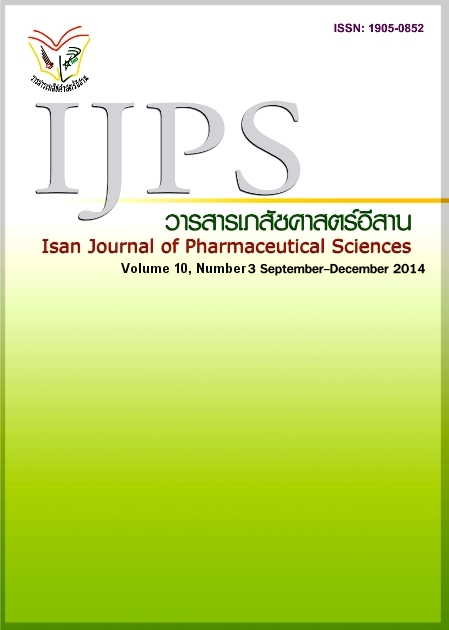Comparing the effectiveness of Nortriptyline and Nicotine gum with counseling for Smoking Cessation in Nicotine Dependence Smokers
Main Article Content
Abstract
Introduction The treatment for nicotine dependence is limited in practice because of a controlled budget and adverse drug reactions.This research aimed to evaluate the effectiveness of nortriptyline(the treatment group) and nicotine gum(the comparision group). Methods This clinical control trial was designed. Both groups received counseling. Researchers collected, the rate of smoking cessation, number of cigarettes smoked per day, levels of carbon monoxide (CO), adherence and adverse drug reactions every month for four months. Results The cessation rates with nortriptyline were 16.8%, 39.4%, 73.7% and 75.0% and with nicotine gum were 18.1%, 34.0%, 67.4% and 70.5% at month 1, 2, 3 and 4, respectively. The decremental proportion of cigarettes smoked per day at month 4 compare with the quiting date were 13.1+5.7 cigarettes/day with nortriptyline and 12.8+6.5 cigarettes/day with nicotine gum, but there was not different between two groups.The incremental proportion of exhaled carbon monoxide (CO) < 10 ppm were 17.4% with nortriptyline and 24.4% with nicotine gum (p<0.05). Adverse drug reactions with nortriptyline and nicotine gum were found 70.3% and 30.5%, respectively. The top three highest adverse drug reactions with nortriptyline were sleepy (56.4%), dry mouth (34.7%) and bitter test (8.9%). And with nicotine gum were flatulent (15.8%), stomach pain (8.4%) and tired jaw (6.3%). Adherence rate was not different between groups (59.2% with nortriptyline and 68.6% with nicotine gum). Conclusions Adverse drug reactions were found higher with nortriptyline than nicotine gum, nevertheless, there was not any serious adverse events within 3 months of the treatment.
Article Details
In the case that some parts are used by others The author must Confirm that obtaining permission to use some of the original authors. And must attach evidence That the permission has been included
References
Ardjula T, et al. Results provide counseling and medication for smoking cessation in the University Pharmacy with the collabora¬tion of primary care services. IJPS 2013, FEB; 9(1): 41.
Banthitanukul K. Compilation and synthesis of the pharmacist’s role in tobacco control. [Online]. 2011 [cited 2011 Sep 8; Avail¬able from:http://info.thaihealth.or.th/li¬brary/10655.
Cahill K, Moher M, Lancaster T. Workplace inter¬ventions for smoking cessation. Co¬chrane database of systematic reviews (Online); 2008(4): p. CD003440.
Cahill K, Perera R, Competitions and incentives for smoking cessation. Cochrane data¬base of systematic reviews (Online); 2010(4): p. CD004307.
Dhippayom T, Thananithisak C. Nortriptyline for Smoking Cessation. Srinagarind Med J; 2010. 25(2): 147-155.
Hall SM, et al. Nortriptyline and cognitive-behav¬ioral therapy in the treatment of cigarette smoking. Pubmed (Online). 1998(8):683-90.
Hollands GJ, et al. Adherence to and consumption of nicotine replacement therapy and the relationship with abstinence within a smoking cessation trial in primary care. Nicotine Tob Res. 2013. 15(9): 1537- 1544.
Hughes JR, et al. Antidepressants for smoking cessation. Cochrane Database of Sys¬tematic Reviews (Online) ; 2014(1).p. CD000031.
Pumsawas W et al., Treatment guidelines and advice to quit smoking for pharmacist. 1st ed. 2003; Bangkok: Department of medicine , ministry of public health.
Rattanawibul N, Jaruenwong, Suksawang W. Results of Mouth Wash for Behavioral change of Official Smoking; Srisangvorn¬sukhothai Hospital. [Online]. 2009 Sep [cited 2011 Sep 3]; Available from: http://www.researchers.in.th/blog/sswhos¬abs/2340.
Rungruenghirunya S, Suntorntham S. Evidence-based clinical practice guidelines, the treatment of tobacco addiction in Thai¬land. 2012; Network of medical profes¬sionals in tobacco.
Rothemich SF, Johnson RE, Devers KJ, et al. Promoting primary care smoking-cessa¬tion support with quitlines: the QuitLink Randomized Controlled Trial. American journal of preventive medicine 2010; 38(4): 367-74.
Sadakorn S, Saengcharoen W, Wongpoowarak P, Lerkiatbundit S. Clinical Impact of Pharmacist Counseling on Type 2 Diabetes Patients. IJPS 2014; JAN; 9(Suppl): 116.
Sittipunt C. A Randomized Controlled Trial to Compare tha Effectiveness of Nortriptyl¬ine plus Brief Motivation Counseling and Motivation Counseling Alone for Smoking Cessation in Thai Active Smokers. [On¬line]. 2548 [cited 2012 Aug 20; Available from: http://cuir.car.chula.ac.th/han¬dle/123456789/7862.
Smoke Free Pharmacy. Background of pharmacy network for tobacco control[Online]. 2014 Aug 11[cited 2013 Oct 28]; [2 screens]. Available rom:http://www.Smokefreephar¬macy.com/aboutphp
Suwanmajo S. The role of pharmacist in helping the smoker. [Online] .2011 [cited 2011 Sep 4]; Available from: http://thaigovweb.com/mophweb/file/doc/news21377-240110-171039.doc.
Watheesathokkit P. Thailand’s death from dis¬eases caused by smoking. [Online] . 2013 [cited 2014 Sep 10]; Available from: http://www.kaiwaisai.com/buddhist/files/download/BBPC.pptx.


